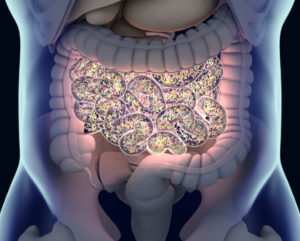
Investigators at Brigham and Women’s Hospital (BWH) have shown that the presence of gut microbiota increases levels of insulin-like growth factor 1 (IGF-1), and supports bone growth in mice.
“We wanted to understand how the gut microbiota regulates bone, because we’re interested in novel ways to improve bone quality and quantity, and ultimately improve the bone health of the population,” says Julia F. Charles, MD, PhD, an investigator who recently joined the Department of Orthopaedic Surgery at BWH.
Dr. Charles conducted the study in collaboration with her postdoctoral fellow, Jing Yan, PhD, as well as R. Balfour Sartor, MD, Director of The National Gnotobiotic Rodent Resource Center (NGRRC). Their findings were published in the Proceedings of the National Academy of Sciences in November 2016.
The investigators colonized germ-free adult mice with microbes, and then compared them to their germ-free siblings. The results demonstrated both short- and long-term effects. After one month, the germ-free mice that were colonized with bacteria lost bone due to increased bone resorption. However, eight months after colonization these mice had larger and longer bones than their germ-free siblings, indicating that microbiota promoted bone formation over the long-term.
Colonized mice also showed higher circulating levels of IGF-1, a hormone critical for bone formation and growth. The increase in circulating IGF-1 reflected large increases in IGF-1 production by the liver of colonized mice. To further test the role of microbiota in stimulating liver IGF-I, the investigators eliminated microbiota in mice with broad-spectrum antibiotics. These mice experienced a decrease in serum IGF-I levels and reduced rates of bone formation.
To understand the mechanism by which microbiota stimulated IGF-1, the researchers investigated whether short chain fatty acids, which are made by microbiota, could increase IGF-1.
“We then gave antibiotic-treated mice short chain fatty acids and saw an increase in IGF-I levels. This suggests that you could potentially increase bone formation by manipulating the microbiota to produce more short-chain fatty acids,” says Dr. Charles.
The study raised many questions, including: could providers one day manipulate the microbiota in patients with poor bone health? Could physicians use probiotics as an adjunct to osteoporosis treatment, or as fracture prevention?
“Before we can answer these questions, we need to better understand how precisely microbiota and short-chain fatty acids increase IGF-I levels. One could imagine a probiotic agent that increased IGF-I levels, which could be used to treat low bone mass or impaired bone growth. We also know that gut microbiota is highly influenced by our lifestyle and diet, so it’s possible that we could change our diet to improve our bone health,” says Dr. Charles.
Dr. Charles and her colleagues are currently following-up this study by conducting defined colonizations with specific bacterial communities in mice to test whether some microbes are better than others at increasing IGF-1. Future studies will aim to elucidate precisely which bacteria contribute to increased IGF-I levels, and whether short chain fatty acids act alone in bone remodeling, or if other microbial metabolites are important for bone health.